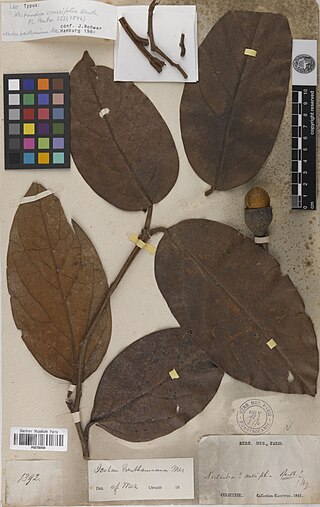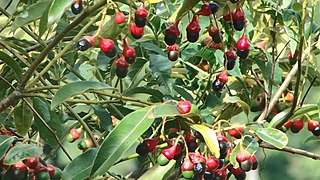
Lauraceae, or the laurels, is a plant family that includes the true laurel and its closest relatives. This family comprises about 2850 known species in about 45 genera worldwide. They are dicotyledons, and occur mainly in warm temperate and tropical regions, especially Southeast Asia and South America. Many are aromatic evergreen trees or shrubs, but some, such as Sassafras, are deciduous, or include both deciduous and evergreen trees and shrubs, especially in tropical and temperate climates. The genus Cassytha is unique in the Lauraceae in that its members are parasitic vines. Most laurels are highly poisonous.

Ocotea is a genus of flowering plants belonging to the family Lauraceae. Many are evergreen trees with lauroid leaves.
Aglaia lancilimba is a species of plant in the family Meliaceae. It is found in Indonesia, Malaysia, and the Philippines.

Ocotea aciphylla is a species of Ocotea in the plant family Lauraceae. It forms a tree 12–18 m tall. It has small hermaphrodite flowers of 3–4 mm long. It is found in the Amazon River basin mostly to 1200 m.

Ocotea basicordatifolia is a species of Ocotea in the plant family Lauraceae.

Ocotea benthamiana is a species of plant in the family Lauraceae. It is a shrub or tree to 15 m tall.

Ocotea catharinensis is a member of the plant family Lauraceae. It is a slow-growing evergreen, a valuable hardwood tree of broad ecological importance, and it is threatened by habitat loss and by overexploitation for its timber and essential oils.

Ocotea clarkei is a species of Ocotea in the plant family Lauraceae. It is an evergreen tree that is endemic to the Mexican state of Chiapas.

Ocotea cymbarum is a species of Ocotea in the plant family Lauraceae. It is an evergreen tree found in Brazil, Colombia, French Guiana, Guyana, Suriname, and Venezuela.

Ocotea foetens, commonly called til or stinkwood is a species of tree in the family Lauraceae. It is evergreen and grows up to 40 m tall. It is a common constituent of the laurisilva forests of Madeira and the Canary Islands. Leaf fossils of this species are known from the Mio-Pleistocene of Madeira Island.

Ocotea kenyensis is a species of plant in the family Lauraceae. It is found in the Democratic Republic of the Congo, Eswatini, Ethiopia, Kenya, Malawi, Mozambique, Rwanda, South Africa, Sudan, Tanzania, Uganda, and Zimbabwe. It is threatened by habitat loss.
Ocotea langsdorffii is a species of plant in the family Lauraceae.
Ocotea otuzcensis is a species of tree in the family Lauraceae. It is endemic to Peru and considered as a vulnerable species by the IUCN.

Ocotea porosa, commonly called imbuia or Brazilian walnut, is a species of plant in the Lauraceae family. Its wood is very hard, and it is a major commercial timber species in Brazil.

Ocotea odorifera is a species of plant in the family Lauraceae. It is an evergreen tree in the genus Ocotea.

Ocotea puberula is a species of evergreen tree in the plant genus Ocotea of the family Lauraceae. It is found in Argentina, Brazil, French Guiana, Guyana, Mexico, Peru, and Suriname.
Ocotea rotundata is a species of evergreen tree in the genus of plants Ocotea, in the family Lauraceae. It is endemic to Ecuador. Its natural habitat is subtropical or tropical moist montane forests.
Ocotea staminoides is a species of evergreen tree in the plant genus Ocotea of the family Lauraceae. It is endemic to Jamaica.
Ocotea uxpanapana is a species of plant in the family Lauraceae. It is a species of evergreen tree in the genus Ocotea.
Polyalthia lancilimba is a species of plant in the Annonaceae family. It is endemic to China.













